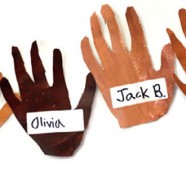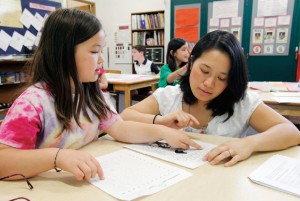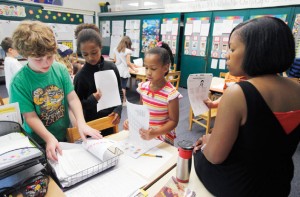
It can start with a simple misunderstanding over whose turn is next. A child whispers to another and someone feels left out. A ball is grabbed playfully, or not so playfully, and there is foot-stamping outrage. Every day in classrooms, hallways and playgrounds, conflicts big and small play out between children of all ages. Equipping them with the tools to manage these conflicts is an important part of early childhood education, particularly in second grade.
“Second grade is a big year, socially,” says Sachiyo Unger, Grade 2 teacher in Milton’s K–8. “The academic piece goes hand in hand with the social element, which is a major part of growth for these 7- and 8-yearolds, as they figure out where they stand. The students have many more words and ways to express themselves, but they don’t know how to deliver their feelings.”
In Sachiyo’s and Tasha Summers’s classrooms, students gather in an “open circle” once a month to learn skills that will help them deal with conflict. The curriculum is based on the book Talk It Out: Confl ict Resolution in the Elementary Classroom. The goal is keeping the children’s confl ict between the children. Using the Talk It Out method, a teacher stays emotionally neutral and helps the students figure out, on their own, how to solve conflict.
During open circle the two classes meet together, and the children physically sit in a circle facing one another and their teachers.
“In the open circles we create an environment that involves cooperation,” says Sachiyo. “The children want to learn about this material, and they are so engaged. We provide a lot of examples and scenarios. To keep the environment safe, students aren’t allowed to use specific names when describing real situations.”
One teacher writes down the children’s thoughts as the other teacher leads the discussion. In a previous session students worked on using “I” statements, and a poster on the wall reminds students what an “I” statement is:
I ____________ (feeling) when you ______________ (specific behavior) because _____________ (how it affects me).
In today’s session, Sachiyo asks the students how many of them have used “I” statements since they last talked. A few hands shoot up and she calls on one boy to share his example.
“I felt bad when you stole my ball because I was playing with it.”
“Great, you told the person how you felt and why,” says Sachiyo. “Now what would an example of a ‘You’ statement be in that situation?”
“You stole my ball!”
“Yes, and this is what people say when they don’t have self-control and just blurt out their feelings. The other person will probably get defensive. But sometimes you are so angry that controlling yourself is diffi cult. What can you do then?” asks Sachiyo.
“You can step back,” says one girl. Another says, “You should think, ‘I’m not going to do this’ and have positive energy.”
At this point, Sachiyo stresses that a child should not just walk away to avoid the conflict. “If you are so mad you are about to cry or say mean things, you can step away, collect yourself, and cool down. However, you need to come back and let the person know how you feel. You can wait one recess time, but not days and days.”
In open circle, Sachiyo says the “students always have great examples. They take the lesson to a new level, and they want to figure out how to make the situations better, especially because they are going to be together for many years. They want to be in a cooperative environment.”
As the book stresses, conflict is natural. Everyday conflicts such as teasing, not sharing, taking toys, cutting in line, and telling secrets are normal interactions between children. It takes time, maturity, and help from adults for children to learn effective conflict resolution—a skill that even adults have trouble mastering.

Sachiyo Unger helps her second graders find the language to express themselves clearly and effectively.
“Second graders are still very young to completely resolve their problems on their own,” says Tasha. “Resolving conflict is hard work, and they need help. When we talk about this as a class, the students have all the right answers and they’re sharing. When it comes to being in the midst of an actual conflict, however, they still get stuck. Though we give them these tools and the language to work through things, they still need us to remind them: ‘Did you use your “I” statement’? They always feel better when they return to the situation and use some of the tools we’ve taught them.”
One of the important tools the teachers impart is the act of listening. Sachiyo moves the discussion in that direction after one student says, “Sometimes, the ‘I’ statement doesn’t work.”
Sachiyo affirms the student’s concern and points out that this is usually because the other person is not listening.
“If you listen, the other person might listen to you, rather than both of you talking and yelling over one another,” says Sachiyo. “If you listen, you might solve the problem more quickly.”
She then has students discuss what good and bad listening looks like and how you know when someone is not listening to you. They move on to finding a fair solution—a topic they spend time on during each open circle. By focusing on each child’s need during a disagreement, they can work toward finding a compromise. For example: If one student wants to read during recess and another wants to build with blocks, the reader wants silence and the block builder wants to make noise. In the end, the students come up with the solution of splitting recess into reading time and block time.
“It may take a while to get there, but walking through the steps of compromising helps the students realize that problems have more than one solution,” says Sachiyo. “It takes patience and listening to each other to figure out how both needs can be met.”
Sachiyo concludes the open circle by reminding students that “confl ict resolution does not mean one of us has to be right. Both perspectives are valid. Everyone has feelings, and sometimes no one is right or wrong—that is just how they feel.”
“Does someone have to be right?” Sachiyo asks the students.
“No!” they shout.
“Can you both be wrong?”
“Yes!” they answer enthusiastically.
The students untangle their crossed legs, stand, and stretch before getting back to their school day, with a larger set of skills for handling the everyday trials of second grade.
–Liz Matson




